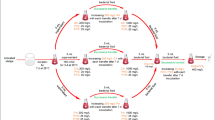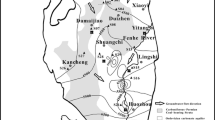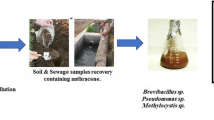Abstract
Polycyclic aromatic hydrocarbons (PAHs) are harmful persistent organic pollutants, while the high-molecular-weight (HMW) PAHs are even more detrimental to the environment and human health. However, microbial anaerobic degradation of HMW PAHs has rarely been reported. One facultative anaerobe Pseudomonas sp. JP1 was isolated from Shantou Bay, Shantou, China, which could degrade a variety of HMW PAHs. After 40 days cultivation with strain JP1, anaerobic biodegradation rate of benzo[a]pyrene (BaP), fluoranthene, and phenanthrene was 30, 47, and 5 %, respectively. Consumption of nitrate as the electron acceptor was confirmed by N-(1-naphthyl) ethylenediamine spectrophotometry. Supplementation of sodium sulfite, maltose, or glycine, and in a salinity of 0–20 ‰ significantly stimulated anaerobic degradation of BaP. Lastly, the anaerobic degradation metabolites of BaP by strain JP1 were investigated using GC/MS, and the degradation pathway was proposed. This study is helpful for further studies on the mechanism of anaerobic biodegradation of PAHs.









Similar content being viewed by others
References
Annweiler E, Michaelis W, Meckenstock RU (2002) Identical ring cleavage products during anaerobic degradation of naphthalene, 2-methylnaphthalene, and tetralin indicate a new metabolic pathway. Appl Environ Microbiol 68:852–858
Coates JD, Woodward J, Allen J, Philip P, Lovley DR (1997) Anaerobic degradation of polycyclic aromatic hydrocarbons and alkanes in petroleum-contaminated marine harbor sediments. Appl Environ Microbiol 63:3589–3593
Coates JD, Chakraborty R, Lack JG, O’Connor SM, Cole KA, Bender KS, Achenbach LA (2001) Anaerobic benzene oxidation coupled to nitrate reduction in pure culture by two strains of dechloromonas. Nature 411:1039–1043
Dandie CE, Thomas SM, Bentham RH, McClure NC (2004) Physiological characterization of Mycobacterium sp. strain 1B isolated from a bacterial culture able to degrade high-molecular-weight polycyclic aromatic hydrocarbons. J Appl Microbiol 97:246–255
Fuchs G, Boll M, Heider J (2011) Microbial degradation of aromatic compound—from one strategy to four. Nat Rev Microbiol 10:1–12
Haritash AK, Kaushik CP (2009) Biodegradation aspects of polycyclic aromatic hydrocarbons (PAHs): a review. J Hazard Mater 169:1–15
Johnsen AR, Wick LY, Harms H (2005) Principles of microbial PAH degradation in soil. Environ Pollut 133:71–84
Li CH, Wong YS, Tam NFY (2010) Anaerobic biodegradation of polycyclic aromatic hydrocarbons with amendment of iron (III) in mangrove sediment slurry. Bioresour Technol 101:8083–8092
Lily YY, Phelps CD (2005) Metabolic biomarkers for monitoring in situ anaerobic hydrocarbon degradation. Environ Health Perspect 113:62–67
Luan T, Fang S, Zhong Y, Lin L, Chan SMN, Lan C, Tam NFY (2007) Determination of hydroxy metabolites of polycyclic aromatic hydrocarbons by fully automated solid-phase microextraction derivatization and gas chromatography–mass spectrometry. J Chromatogr A 1173:37–43
Mahmood Q, Zheng P, Cai J, Wu D, Hu B, Li J (2007) Anoxic sulfide bio-oxidation using nitrite as electron acceptor. J Hazard Mater 147(1):249–256
Meckenstock RU, Safinowski M, Griebler C (2004) Anaerobic degradation of polycyclic aromatic hydrocarbons. FEMS Microbiol Ecol 49(1):27–36
Nieman JKC, Sims RC, Mclean JE, Sorensen D (2001) Fate of pyrene in contaminated soil amended with alternate electron acceptors. Chemosphere 44:1265–1271
Oppenheimer CH (1952) The growth and viability of sixty-three species of marine bacteria as influenced by hydrostatic pressure. J Mar Res 11:10–18
Rafin C, Veignie E, Fayeulle A, Surpateanu G (2009) Benzo[a]pyrene degradation u sing simultaneously combined chemical oxidation, biotreatment with Fusarium solani and cyclodextrins. Bioresour Technol 100:3157–3160
Rockne KJ, Strand SE (2001) Anaerobic biodegradation of naphthalene, phenanthrene and biphenyl by a denitrifying enrichment culture. Water Res 35:291–299
Rothermich MM, Hayes LA, Lovley DR (2002) Anaerobic, sulfate-dependent degradation of polycyclic aromatic hydrocarbons in petroleum-contaminated harbor sediments. Environ Sci Technol 36:4811–4817
Schreiber K, Benkert B, Eschbach M, Jahn D (2007) The anaerobic regulatory network required for Pseudomonas aeruginosa nitrate respiration. J Bacteriol. 3:4310–4314
Shi DQ, Zhao JS, Yang JR, Hou YF, Kong Y (2004) Degradation of dibenzothiophene by Pseudomonas stutzeri UPl. China Environ Sci 24:730–733
Song L, Wang H, Shi IHC (2007) The function study on trichlorobenzene degradation by plasmid pT7. China Environ Sci 27:121–124
Song XH, Xu Y, Li GM, Zhang Y, Huang TW, Hu Z (2011) Isolation, characterization of Rhodococcus sp. P 14 capable of degrading high-molecular-weight polycyclic aromatic hydrocarbons and aliphatic hydrocarbons. Mar Pollut Bull 62:2122–2128
Strohm TO, Walter BJ, Schink B (2007) Growth yields in bacterial denitrification and nitrate ammonification. Appl Environ Microbiol 73:1420–1424
Sun M, Ye M, Hu F, Li H, Teng Y, Luo Y, Jiang X, Kengara FO (2014) Tenax extraction for exploring rate-limiting factors in methyl-β-cyclodextrin enhanced anaerobic biodegradation of PAHs under denitrifying conditions in a red paddy soil. J Hazard Mater 264:505–513
Thauer RK, Jungermann K, Decker K (1977) Energy conservation in chemotrophic anaerobic bacteria. Bacteriol Rev 41:100–180
Verdin A, Anissa Sahraoui LH, Durand R (2004) Degradation of benzo[a]pyrene by mitosporic fungi and extracellular oxidative enzymes. Int Biodeter Biodegr 53:65–70
Wu YR, He TT, Zhong MQ, Zhang YL, Li EM, Huang TW, Hu Z (2009) Isolation of marine benzo[a]pyrene-degrading Ochrobactrum sp. BAP5 and proteins characterization. J Environ Sci 21:1446–1451
Yan Z, Jiang H, Li X, Shi Y (2014) Accelerated removal of pyrene and benzo[a]pyrene in freshwater sediments with amendment of cyanobacteria-derived organic matter. J Hazard Mater 272:66–74
Zhang X, Sullivan ER, Young LY (2000) Evidence for aromatic ring reduction in the biodegradation pathway of carboxylated naphthalene by a sulfate reducing consortium. Biodegradation 11(2–3):17–124
Acknowledgments
This work was supported partly by National Science Foundation of China (Nos.41076073, 30970106).We thank Mrs. Xiaoshan Zhang, Mr. Tufeng Chen for assistance in GC/MS and HPLC analysis. We are grateful to Prof. Guangming Xiong (Kiel University) for helpful suggestions.
Author information
Authors and Affiliations
Corresponding author
Electronic supplementary material
Below is the link to the electronic supplementary material.
Rights and permissions
About this article
Cite this article
Liang, L., Song, X., Kong, J. et al. Anaerobic biodegradation of high-molecular-weight polycyclic aromatic hydrocarbons by a facultative anaerobe Pseudomonas sp. JP1. Biodegradation 25, 825–833 (2014). https://doi.org/10.1007/s10532-014-9702-5
Received:
Accepted:
Published:
Issue Date:
DOI: https://doi.org/10.1007/s10532-014-9702-5




